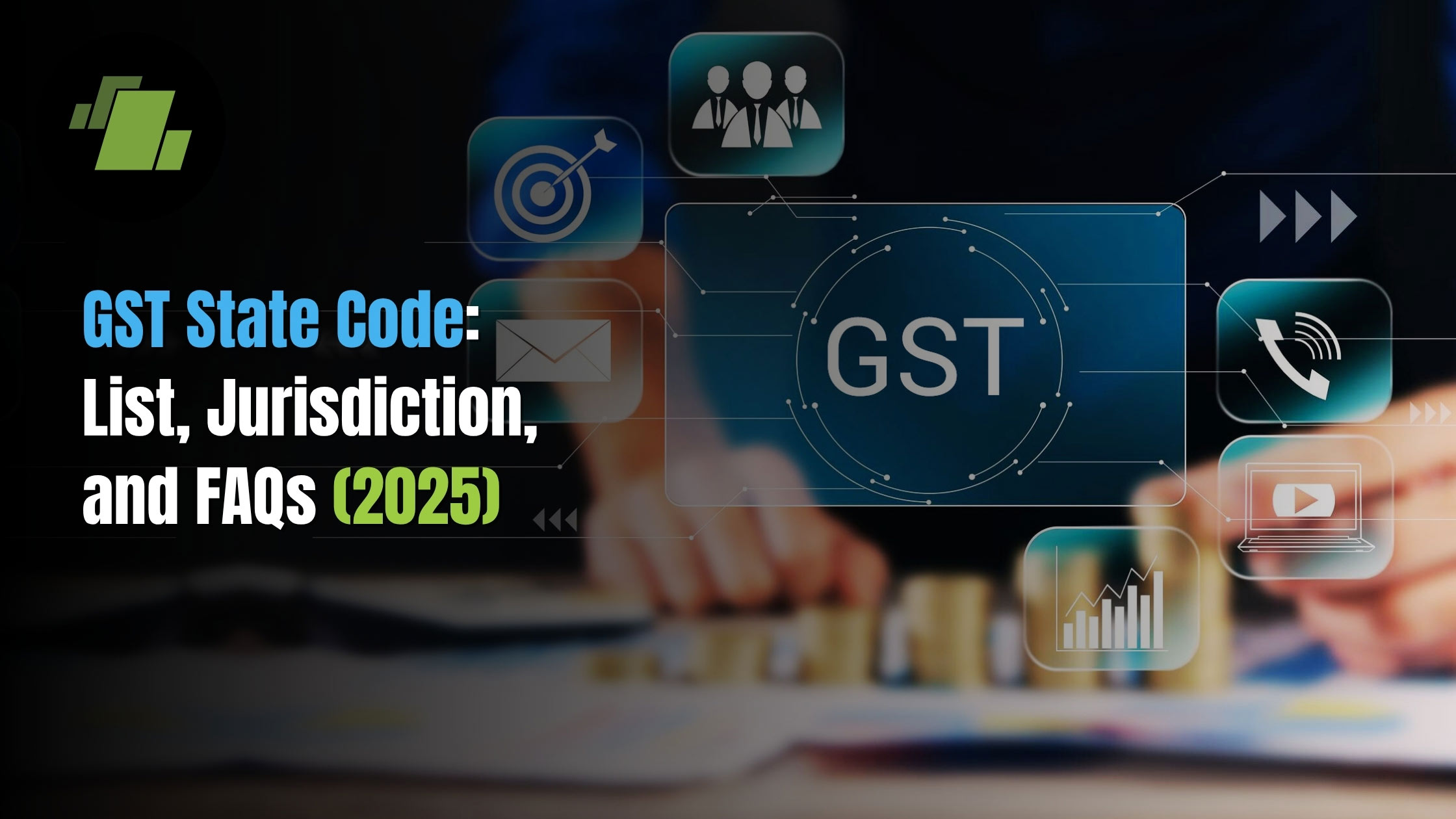GST State Code: List, Jurisdiction, and FAQs (2025 Updated)


Summary
Stay GST-compliant with the latest 2025 GST State Code list for all Indian states and union territories. This guide explains jurisdiction, GSTIN format and answers frequently asked tax queries.
Table of Content
- What is GST State Code?
- Why is the GST State Code Important?
- Updated GST State Code List 2025 [Table]
- How GST State Codes Are Used in GSTIN & Invoices?
- Where Do You Need the GST State Code?
- Understanding GST Jurisdiction (State vs Centre)
- How to Find Your GST State Code & Jurisdiction?
- Objective of GST State Codes
- Significance of Knowing GST State Code & Jurisdiction
- What to Do if Your GST State Code/Jurisdiction is Wrong?
- Frequently Asked Questions
Definition of GST State Code
GST State code is the unique identification number representing every State/UT in which the taxpayer is registered under the GST law. It’s a two-digit numeric code that serves as a crucial identifier in India’s Goods and Services Tax system. These codes are represented by numbers assigned to each state and Union Territory. For example, GST state code 27 represents Maharashtra, while GST state code 29 represents Karnataka.
Explanation of its Role in GSTIN
GSTIN (Goods and Services Tax Identification Number) is a unique 15-digit number assigned to every registered taxpayer. The first two digits of the GSTIN represent the state code, making it the primary identifier for determining the geographical jurisdiction of a GST-registered business. This systematic approach ensures seamless tax administration across India’s diverse states and union territories.
Example Showing How State Codes Represent State/UTs in GSTIN
Let’s understand this with practical examples:
- Punjab is ’03’, West Bengal is ’19’, Tamil Nadu is ’33’
- The code for Delhi is 07, Karnataka is 29, and Uttar Pradesh is 09
- If a GSTIN starts with “27”, it immediately identifies the business as registered in Maharashtra
- Similarly, a GSTIN beginning with “24” indicates registration in Gujarat
Why is the GST State Code Important?
Role in GST Registration, Return Filing, and Invoicing
GST state codes and GST state code meaning/information is fundamental to the entire GST ecosystem. During GST registration, businesses must provide accurate state codes to ensure proper jurisdictional assignment. Taxpayers must use the GST state code during GST registration and while entering details in GST Returns. This ensures that all tax-related communications, GST tax compliance, audits, and compliance activities are handled by the correct state GST authorities.
How It Helps Define Place of Supply (CGST/SGST vs. IGST)?
The GST state code plays a critical role in determining tax structure:
- Intra-state transactions: When buyer and seller have the same state code, CGST (Central GST) and SGST (State GST) apply
- Inter-state transactions: When state codes differ, IGST (Integrated GST) applies
- This automatic determination ensures correct tax calculation and compliance with GST law
Importance for Correct Tax Jurisdiction and Compliance
When a taxpayer registers on the GST portal, a temporary GST state code is issued, which becomes permanent after seven working days, provided all documents are verified and accepted. Correct state codes ensure:
- Proper allocation of tax revenues between states
- Accurate jurisdictional oversight
- Seamless inter-state trade facilitation
- Reduced compliance errors and penalties
Updated GST State Code List 2025
Full Table Listing: State/UT name, State Code, Alpha Code (abbreviation)
GST State Code List for Indian States & Union Territories: Explore GST Code Utility State-Wise
| State/UT | GST State Code | Alpha Code |
|---|---|---|
| Jammu and Kashmir | 01 | JK |
| Himachal Pradesh | 02 | HP |
| Punjab | 03 | PB |
| Chandigarh | 04 | CH |
| Uttarakhand | 05 | UT |
| Haryana | 06 | HR |
| Delhi | 07 | DL |
| Rajasthan | 08 | RJ |
| Uttar Pradesh | 09 | UP |
| Bihar | 10 | BR |
| Sikkim | 11 | SK |
| Arunachal Pradesh | 12 | AR |
| Nagaland | 13 | NL |
| Manipur | 14 | MN |
| Mizoram | 15 | MZ |
| Tripura | 16 | TR |
| Meghalaya | 17 | ML |
| Assam | 18 | AS |
| West Bengal | 19 | WB |
| Jharkhand | 20 | JH |
| Odisha | 21 | OR |
| Chhattisgarh | 22 | CG |
| Madhya Pradesh | 23 | MP |
| Gujarat | 24 | GJ |
| Dadra and Nagar Haveli and Daman and Diu | 26 | DN |
| Maharashtra | 27 | MH |
| Andhra Pradesh | 28 | AP |
| Karnataka | 29 | KA |
| Goa | 30 | GA |
| Lakshadweep | 31 | LD |
| Kerala | 32 | KL |
| Tamil Nadu | 33 | TN |
| Puducherry | 34 | PY |
| Andaman and Nicobar Islands | 35 | AN |
| Telangana | 36 | TS |
| Ladakh | 37 | LA |
Recent Territorial Changes Affecting GST State Codes (e.g., Merger of UTs, Addition of Ladakh)
New GST state code 26* is for merged UTs of Dadra and Nagar Haveli and Daman and Diu – this merger became effective from January 26, 2020. Before January 26, 2020, the former UT of Daman and Diu’s GST state code was 25. Additionally, Ladakh was assigned state code 37 after its formation as a separate Union Territory in 2019.
How GST State Codes are Used in GSTIN & Invoices?
Detailed Breakdown of GSTIN’s 15 digits
The 15-digit GSTIN structure follows this format:
- Digits 1-2: State Code (e.g., 27 for Maharashtra)
- Digits 3-12: PAN of the taxpayer (10 digits)
- Digit 13: Entity code (assigned based on business type)
- Digit 14: Alphanumeric check code
- Digit 15: Default value ‘Z’
Visual Example GSTIN with State Code Marked
Example GSTIN: 27AABCU9603R1Z5
- 27 = Maharashtra (State Code)
- AABCU9603R = Business PAN
- 1 = Entity code
- Z = Default value
- 5 = Check code
Emphasize Invoice and Return Filing Using the Correct State Code
Accurate state codes are mandatory for:
- GST Invoices: Ensures correct tax calculation and jurisdiction
- GSTR-1 Returns: Accurate reporting of outward supplies
- GSTR-3B Returns: Monthly summary returns with proper state-wise bifurcation
- e-Invoicing: Automated validation requires correct state codes
Where Do You Need the GST State Code?
GST Registration (forms, portals)
During GST registration on the official GST portal, businesses must provide:
- Principal place of business address with correct state
- State code gets auto-populated based on address
- Additional place of business registrations require respective state codes
GST Invoice & e-Invoicing
Every GST invoice must contain:
- Supplier’s GSTIN (with state code)
- Recipient’s GSTIN (with state code)
- Place of supply determination based on state codes
- Automatic tax type selection (CGST/SGST or IGST)
GSTR-1 and GSTR-3B filing, tax reporting
Monthly and quarterly returns require:
- State-wise segregation of supplies
- Correct state code reporting for input tax credit claims
- Inter-state and intra-state transaction bifurcation
ITC (Input Tax Credit) matching
Input tax credit matching between buyer and seller depends on:
- Accurate state code reporting in GSTR-1
- Proper invoice details with correct jurisdictional information
- Auto-matching of credits through GST portal
GST software usage
All GST-compliant software requires:
- State code configuration during setup
- Automatic tax calculation based on state codes
- Compliance reporting with jurisdictional accuracy
Understanding GST Jurisdiction (State vs Centre)
What is GST jurisdiction? (Definition, Types)
GST jurisdiction refers to the administrative authority and geographical area under which a taxpayer operates for GST compliance purposes. The government organizes GST authorities by region and area PIN codes, creating a structured hierarchy for tax administration.
Difference Between State and Central Jurisdictions
State GST Jurisdiction:
- Handles SGST matters
- State-specific compliance issues
- Local trade and business regulations
- Revenue collection for state government
Central GST Jurisdiction:
- Manages CGST and IGST matters
- Inter-state trade facilitation
- Uniform policy implementation
- Central revenue collection
Hierarchy of GST Zones, Divisions, and Ranges
The GST administrative structure follows:
- Zones: Macro-level geographical divisions
- Commissionerates: State/region-specific administrative units
- Divisions: District or area-based subdivisions
- Ranges: Local administrative circles for direct taxpayer interaction
How to Find Your GST State Code & Jurisdiction?
Method 1: Through the CBIC portal (Know Your Jurisdiction)
The Central Board of Indirect Taxes and Customs (CBIC) provides an online tool:
- Visit the official CBIC website
- Navigate to “Know Your Jurisdiction” section
- Enter your business address or PIN code
- System displays your GST jurisdiction and state code
Method 2: Using GST Portal and GSTIN
If you’re already GST registered:
- Log into the GST portal with your credentials
- Check your GSTIN – first two digits are your state code
- View complete jurisdiction details in your profile
- Download jurisdiction certificate if required
Method 3: State GST Department Websites
Each state GST department provides jurisdiction information:
- Visit your state’s official GST website
- Use jurisdiction finder tools
- Contact local GST offices for clarification
- Access state-specific compliance guidelines
Bonus: Automated GSTIN/State Code Lookup Tools
Several third-party tools offer:
- Instant GSTIN validation
- State code identification
- Jurisdiction mapping
- Bulk lookup facilities for businesses
Objective of GST State Codes
Why the Coding System Was Introduced?
The GST state code system was introduced to:
- Standardize Identification: Create uniform identification across all states and UTs
- Simplify Administration: Enable systematic tax administration and compliance monitoring
- Facilitate Technology Integration: Support digital platforms and automated processes
- Ensure Accurate Revenue Distribution: Enable precise allocation of tax revenues to respective states
How it Ensures Accurate, Fair Tax Distribution and Simplifies Compliance?
The coding system achieves its objectives through:
- Automated Revenue Sharing: IGST collected gets automatically apportioned between origin and destination states
- Simplified Compliance: Businesses can easily identify jurisdictional requirements
- Reduced Errors: Standardized codes minimize manual errors in tax calculations
- Enhanced Monitoring: Tax authorities can track and monitor transactions effectively
Significance of Knowing GST State Code & Jurisdiction
Compliance, Correct Audits, Avoiding Penalties
Understanding your GST state code and jurisdiction helps:
- Prevent Compliance Violations: Ensures filing returns with correct jurisdictional authorities
- Audit Preparedness: Helps businesses prepare for jurisdiction-specific audit requirements
- Penalty Avoidance: Reduces risk of penalties due to incorrect jurisdictional filings
- Smooth Operations: Facilitates hassle-free business operations across states
Inter/intra-state Trade, Proper GST Rates, Place of Supply
Knowledge of state codes enables:
- Correct Tax Application: Automatic determination of CGST/SGST vs. IGST
- Place of Supply Rules: Proper application of place of supply provisions
- Rate Determination: Ensures correct GST rate application based on transaction type
- Documentation Accuracy: Maintains proper invoice and return filing documentation
Technology & Software Accuracy
Modern GST compliance relies on:
- Software Configuration: Proper setup of GST software with correct state codes
- API Integration: Seamless integration with GST portal APIs
- Automated Calculations: Error-free tax calculations and return preparations
- Real-time Compliance: Instant validation and compliance checking
What to Do if Your GST State Code/Jurisdiction Is Wrong?
Step-by-Step Guide to Correction via GST portal (“Core Field Amendment”)
If you discover incorrect state code or jurisdiction:
Step 1: Log into GST Portal
- Access the official GST portal with your credentials
- Navigate to “Services” > “Registration” > “Amendment of Registration”
Step 2: Select Amendment Type
- Choose “Core Field Amendment” option
- Select “Principal Place of Business” for address changes
Step 3: Submit Required Documents
- Provide proof of correct address
- Submit supporting documents as per portal requirements
- Pay applicable fees for amendment processing
Step 4: Track Application Status
- Monitor application progress through portal
- Respond to any queries from tax authorities
- Download amended registration certificate once approved
When to contact GST Jurisdictional Officer?
Contact your jurisdictional officer when:
- Complex Cases: Amendment involves multiple state registrations
- Technical Issues: Portal-related problems prevent online amendment
- Urgent Requirements: Business operations affected by incorrect jurisdiction
- Clarification Needed: Uncertainty about amendment requirements or procedures
Contact Process:
- Identify your current jurisdictional officer through GST portal
- Schedule appointment or submit written application
- Provide all relevant documents and explanations
- Follow up regularly on application status
- Obtain written confirmation of jurisdiction correction
Conclusion
Understanding GST state codes and jurisdictions is important for successful GST compliance in India. With the updated 2025 list and comprehensive guidance provided above, businesses can ensure accurate compliance, avoid penalties, and operate smoothly across different states and union territories. Regular updates and proper jurisdiction identification remain crucial for maintaining compliance with India’s dynamic GST ecosystem.
If you are looking for the best GST software, contact LOGIC ERP Team for demo at +91-73411-41176 or send us an email at sales@logicerp.com today!
Frequently Asked Questions (FAQ) on GST State Codes
What is Maharashtra State Code?
The GST state code for Maharashtra is 27. It is used as the first two digits of the 15-digit GSTIN for businesses registered in Maharashtra.
How to find the State Code in the GST Number?
The first two digits of a GSTIN represent the state code. For example, a GSTIN starting with “27” means the business is registered in Maharashtra.
What is State Code 99 in GST?
GST State Code 99 is used for foreign diplomatic missions and other non-resident taxpayers who are not tied to any specific Indian state.
When was GST started in India?
GST was implemented in India on July 1, 2017. It replaced a complex system of indirect taxes with a unified tax structure across the country.
What is the 02 GST State Code?
The GST state code 02 is for Himachal Pradesh. It appears as the first two digits of GSTINs registered in that state.
What is the 03 State Code in GST?
03 GST State Code indicates Punjab. It’s used in the GSTIN for businesses registered in Punjab.
What is the 05 GST State Code?
State Code 05 in GST is for Uttarakhand. It helps identify GST registrations from that region.
What is the 06 State Code in GST?
06 GST state code is assigned to Haryana. It’s used as the prefix in GSTINs issued in the state.
What is the 07 State Code in GST?
07 GST State Code is for Delhi. This identifies all businesses registered in the National Capital Territory.
What is the 08 State Code in GST?
08 GST State Code represents Rajasthan. It is part of every GSTIN registered in Rajasthan.
What is the 09 GST State Code?
09 GST state code is used for Uttar Pradesh. Businesses registered in UP have GSTINs starting with 09.
What is the 10 State Code in GST?
GST State Code 10 corresponds to Bihar. All GSTINs from Bihar begin with 10.
What is the 19 State Code in GST?
State Code 19 in GST is for West Bengal. It is used in the GSTIN for businesses located in that state.
What is the 20 GST State Code?
20 is the GST code for Jharkhand. This helps identify GST registrations from that state.
What is the 22 State Code in GST?
22 GST state code is allocated for Chhattisgarh. It appears as the starting digits in GSTINs for that region.
What is the 23 State Code in GST?
23 is the GST code for Madhya Pradesh. This number is part of the GSTIN issued to MP-based businesses.
What is the 24 State Code in GST?
24 GST state code is for Gujarat. GSTINs from Gujarat begin with this code.
What is the 26 GST State Code?
GST State Code 26 is for Dadra and Nagar Haveli and Daman and Diu. This union territory uses code 26 in its GSTINs.
Which State GST Code is 27?
GST Code 27 is for Maharashtra. It is used in all GSTINs issued for registrations in Maharashtra.
What is the 29 GST State Code?
29 GST state code indicates Karnataka. It is included in the GSTINs for Karnataka-registered entities.
What is the 37 State Code in GST?
33 GST State Code represents Tamil Nadu.
What is the 36 State Code in GST?
36 GST state code represents Telangana. GSTINs in this state begin with 36.
What is the 37 State Code in GST?
37 is the GST code for Andhra Pradesh. It indicates registrations under GST in this state.
What is the GST State Code?
The GST State Code is a unique two-digit number assigned to every Indian state and union territory for GST compliance. It is the first part of the 15-digit GSTIN (Goods and Services Tax Identification Number) and helps identify the location of the registered taxpayer.
Note: GST State Code is different from a postal pin code or administrative state code used for other government purposes.
How do I find the GST State Code for my state?
You can refer to the official GST State Code list on the GST portal or use a reliable GSTIN verification tool. Each state has a fixed code. For example, Maharashtra is 27, Delhi is 07.
Tip: Use the GSTIN itself, the first two digits represent your GST State Code.
Can a business have more than one GST State Code?
Yes. If your business operates in multiple states or UTs, you need to obtain a separate GSTIN for each location. Each GSTIN will carry the respective state code based on the place of registration.
What happens if I use the wrong GST State Code in invoices or returns?
Using the wrong state code can lead to GST mismatches, input tax credit (ITC) rejections, compliance notices, and even penalties. Always double-check the state code when creating invoices or filing GST returns.
Is the GST State Code mandatory on every invoice?
Yes, for all GST-registered businesses, the state code is mandatory as part of the GSTIN on invoices. It’s essential to correctly determine the place of supply, which impacts tax calculation and reporting.
What is the GSTIN, and how is the GST State Code part of it?
The GSTIN is a 15-digit unique number. The first two digits are the GST State Code, followed by the PAN, entity code, and checksum digit.
Example: In GSTIN 27ABCDE1234F1Z5, “27” is the Maharashtra state code.
Are GST State Codes and jurisdiction codes the same?
No. While the GST State Code defines the location of the business, the jurisdiction code identifies the tax authority or officer responsible for overseeing your GST compliance.
Can I check my GST jurisdiction online?
Yes. You can verify your GST jurisdiction using the CBIC portal or your state’s GST website. Input your GSTIN or address to find your GST officer and jurisdiction circle.
Have GST State Codes changed after new states or UTs were formed?
Yes. For example, Ladakh received its own code (37), and the UTs of Dadra & Nagar Haveli and Daman & Diu were merged into code 26. Always use the latest GST state code list.
Why is the GST State Code important for Input Tax Credit (ITC)?
The correct state code ensures that your input tax credit is matched accurately with supplier data. Mismatched codes can cause reconciliation issues, resulting in delayed or denied ITC.
Where can I download the official GST State Code list?
You can download the latest state code list from the official GST portal or CBIC website. LOGIC ERP provides updated reference tables within their GST modules.
How do I correct my GST State or jurisdiction in records?
To update incorrect state code or jurisdiction details, submit an amendment application on the GST portal. It may require address proof and additional documentation depending on the type of correction.
Can two businesses in the same state have different GST State Codes?
No. Businesses operating within the same state will have the same state code. Different GST State Codes apply only if businesses are registered in different states or UTs.
What is the GST State Code for Maharashtra, Gujarat, Karnataka, and Delhi?
Maharashtra – 27
Gujarat – 24
Karnataka – 29
Delhi – 07
For a full list, refer to the GST State Code table.
Is the GST State Code the same as the CIN (Company Identification Number) Code?
No. The GST State Code is used in GSTIN for taxation, while CIN is used for identifying registered companies under the Ministry of Corporate Affairs (MCA). They serve different compliance purposes.
Does GST software auto-fill the GST State Code?
Yes, most reliable GST software and e-invoicing tools, like LOGIC ERP, auto-fill state codes based on your GSTIN. However, it’s still important to manually verify accuracy before finalizing returns or invoices.
What is the meaning of the GST State Code?
The GST State Code is a two-digit number assigned to every Indian state and union territory under the Goods and Services Tax (GST) system. It appears at the beginning of a business’s GSTIN and helps identify the location of registration, which is essential for determining the place of supply and applicable tax rules.
How does the GST State Code help with tax compliance?
The GST State Code ensures accurate tax filing, proper allocation of input tax credit (ITC), and correct classification of inter-state or intra-state transactions. Using the correct state code in invoices and returns helps avoid mismatches, penalties, and delays in ITC processing.






